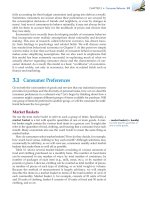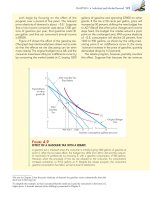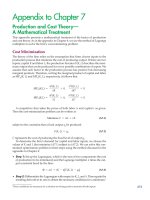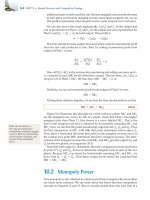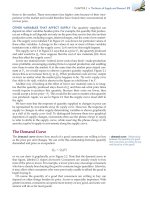(8th edition) (the pearson series in economics) robert pindyck, daniel rubinfeld microecon 735
Bạn đang xem bản rút gọn của tài liệu. Xem và tải ngay bản đầy đủ của tài liệu tại đây (93.19 KB, 1 trang )
710 • GLOSSARY
D
deadweight loss (page 321) Net loss of total (consumer
plus producer) surplus.
decreasing returns to scale (page 223) Situation in
which output less than doubles when all inputs are
doubled.
decreasing-cost industry (page 309) Industry whose
long-run supply curve is downward sloping.
degree of economies of scope (SC) (page 260)
Percentage of cost savings resulting when two or
more products are produced jointly rather than
individually.
demand curve (page 23) Relationship between the
quantity of a good that consumers are willing to buy
and the price of the good.
derived demand (page 530) Demand for an input that
depends on, and is derived from, both the firm’s
level of output and the cost of inputs.
deviation (page 162) Difference between expected payoff and actual payoff.
diminishing marginal utility (page 95) Principle that
as more of a good is consumed, the consumption of
additional amounts will yield smaller additions to
utility.
discount rate (page 569) Rate used to determine the
value today of a dollar received in the future.
diseconomies of scale (page 256) Situation in which a
doubling of output requires more than a doubling
of cost.
diseconomies of scope (page 259) Situation in which
joint output of a single firm is less than could be
achieved by separate firms when each produces a
single product.
diversifiable risk (page 574) Risk that can be eliminated
either by investing in many projects or by holding
the stocks of many companies.
diversification (page 170) Practice of reducing risk by
allocating resources to a variety of activities whose
outcomes are not closely related.
dominant firm (page 476) Firm with a large share
of total sales that sets price to maximize profits,
taking into account the supply response of smaller
firms.
dominant strategy (page 490) Strategy that is optimal
no matter what an opponent does.
double marginalization (page 442) When each firm
in a vertical chain marks up its price above its marginal cost, thereby increasing the price of the final
product.
duality (page 154) Alternative way of looking at the
consumer’s utility maximization decision: Rather
than choosing the highest indifference curve, given
a budget constraint, the consumer chooses the lowest budget line that touches a given indifference
curve.
duopoly (page 458) Market in which two firms compete
with each other.
Dutch auction (page 517) Auction in which a seller
begins by offering an item at a relatively high price,
then reduces it by fixed amounts until the item is
sold.
E
economic cost (page 230) Cost to a firm of utilizing economic resources in production.
economic efficiency (page 323) Maximization of aggregate consumer and producer surplus.
economic rent (page 302) Amount that firms are willing
to pay for an input less the minimum amount necessary to obtain it.
economies of scale (page 256) Situation in which output
can be doubled for less than a doubling of cost.
economies of scope (page 259) Situation in which joint
output of a single firm is greater than output that
could be achieved by two different firms when each
produces a single product.
Edgeworth box (page 603) Diagram showing all
possible allocations of either two goods between two
people or of two inputs between two production
processes.
effective yield (or rate of return) (page 566) Percentage
return that one receives by investing in a bond.
efficiency wage (page 655) Wage that a firm will pay to
an employee as an incentive not to shirk.
efficiency wage theory (page 654) Explanation for the
presence of unemployment and wage discrimination which recognizes that labor productivity may be
affected by the wage rate.
elasticity (page 33) Percentage change in one variable
resulting from a 1-percent increase in another.
emissions fee (page 668) Charge levied on each unit of
a firm’s emissions.
emissions standard (page 668) Legal limit on the
amount of pollutants that a firm can emit.
endowment effect (page 190) Tendency of individuals
to value an item more when they own it than when
they do not.
Engel curve (page 116) Curve relating the quantity of a
good consumed to income.
English (or oral) auction (page 517) Auction in which a
seller actively solicits progressively higher bids from
a group of potential buyers.

